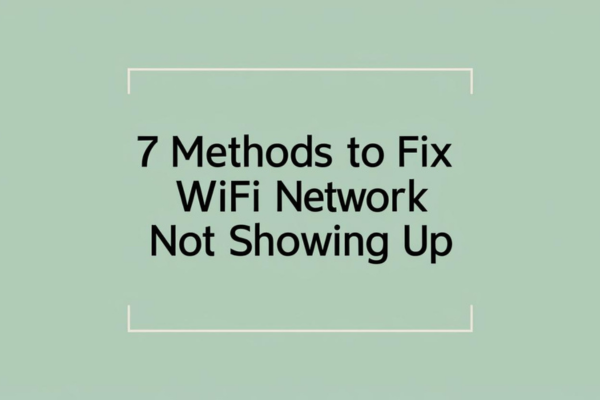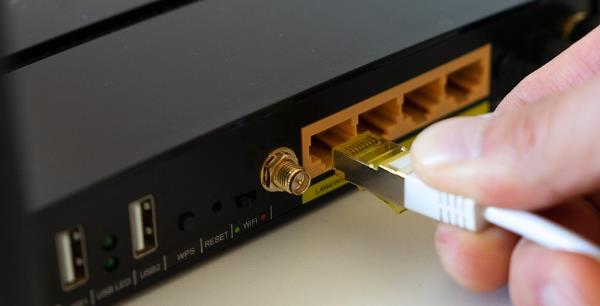If you've ever tried to connect to the internet on your laptop or computer only to find your usual WiFi network not showing up, you know how frustrating it can be. This issue can disrupt your work, online entertainment, and communication. But don't worry; there are several ways to fix it. In this blog, we'll explore seven effective methods to fix WiFi not showing up on laptop and get your WiFi network back on the list of available networks.

How to Fix WiFi Network Not Showing Up Issue?
Method 1: Check Your Physical Setup
The first and simplest thing to do is to ensure that all the necessary hardware is in working order and properly connected.
Router Power: Make sure your router is plugged into a power source and is turned on. Sometimes, a simple power outage or accidental unplugging can cause your router to stop working. If you're not sure, check the power indicator lights on the router. They should be lit up, indicating that the router is receiving power.
WiFi Switch on Laptop: Some laptops, like those from HP, Lenovo, or Dell, have a physical switch or a combination of keys on the keyboard (such as fn + f5) to turn the WiFi on or off. Check if your laptop has such a switch and make sure it's in the "on" position. If it's off, flip it on and see if the WiFi networks around you start showing up.
Method 2: Restart Your Devices
A simple restart can often fix many technical glitches, and the laptop WiFi not showing up issue is no exception.
Restart Your Laptop or Computer: Close all your open applications and files, then restart your device. This can clear any temporary software glitches that might be preventing your device from detecting the WiFi network. In some cases, you might need to force your computer off by holding down the power button for about a minute. This is not the typical way of rebooting, but it can be effective in resolving stubborn issues. Once it's off, wait a few seconds before turning it back on.

Reboot Your Modem and Router: Unplug the power cords from both your modem and router. Wait approximately 30 seconds and then reconnect them. Let the devices fully boot up. Power cycling these devices can often fix internet connectivity issues and problems with wireless connections. Sometimes, the router might encounter a problem that can be resolved by simply restarting it.
Method 3: Enable Your WiFi
Your Windows operating system might have disabled the WiFi service, which could be the reason for your WiFi network not showing up.
Using the WiFi Switch (if available): As mentioned earlier, if your laptop has a dedicated WiFi switch or key combination, make sure it's enabled. This is a quick way to ensure that the hardware side of the WiFi connection is active.
Checking Network Settings: If your device doesn't have a physical WiFi switch, you can check the network settings in your system. Right-click the internet icon on your taskbar and select "Open Network and Sharing Center". Scroll down and choose "Advanced Network Settings" (in Windows 10, click "Change adapter settings"). Then, click "More network adapter options". Right-click on "WiFi" (it might be called "Wireless Network Connection" on some computers) and select "Enable". If it's already enabled, you'll see "Disable" as the option when you right-click. After making the change, restart your Windows and try reconnecting to the WiFi.

Method 4: Turn on WLAN AutoConfig
The WLAN AutoConfig service (known as Wireless Configuration in Windows XP) is responsible for configuring wireless security and connectivity settings. When it's enabled, it applies to all IEEE 802.11 wireless network adapters on your computer and can automatically connect to a preferred wireless network when it becomes available.
Press the Windows logo key + R on your keyboard simultaneously to open the Run box. Type "services.msc" and press Enter.
In the Services window, find "WLAN AutoConfig" (or "Wireless Configuration" for Windows XP users). Right-click on it and select "Properties".
Under the "General" tab, change the "Startup type" to "Automatic". Then click "Apply" and "OK".
Restart your PC and try reconnecting to the WiFi network to see if it shows up.
Method 5: Update Network Driver
An outdated, missing, or corrupt wireless network driver can cause the WiFi not showing up on laptop or computer. Wireless network drivers allow your operating system to communicate with your wireless and network adapters.
Manual Update: You can manually update the network driver by visiting the manufacturer's website. Search for the correct driver that is compatible with your Windows operating system. Download the driver and install it on your computer. However, this process requires some time and computer skills. You need to be sure that you're downloading the right driver for your specific hardware model.
Automatic Update with Driver Sentry: If you don't have the time or patience to manually update drivers, PcGoGo Driver Sentry is an excellent option. PcGoGo Driver Sentry can scan your system to detect any outdated, missing, or faulty drivers. It then downloads and installs the best-matched drivers for your computer hardware and all connected peripheral devices. Here's how to use it:
First, download and install PcGoGo Driver Sentry. If your Windows can't access the internet, you can download it from another computer and transfer it to your problem device using a USB drive.
Run PcGoGo Driver Sentry and click "Scan Now". The program will scan your computer and identify any problem drivers, including those related to your WiFi network adapter.
Click the "Update" button next to your WiFi network driver to automatically download and install the correct version of the driver. You can also click "Update All" to update all the drivers that are missing or out of date on your system. Note that some advanced features might require you to upgrade to the pro version, which offers a free trial period.
After updating the drivers, restart your computer and try connecting to the WiFi network again.

Method 6: Check Device Interference
There could be interference from other devices that is preventing your WiFi network from showing up.
Physical Obstacles: Numerous objects around your home or office can interfere with a wireless router. Thick walls, large appliances like refrigerators or microwaves, and fluorescent lights can all disrupt the WiFi signal. Try to move your router to a more central location, away from such potential sources of interference.
Neighboring Wireless Networks: Other wireless networks in your vicinity can also interfere with your own. Give changing the WiFi channel on your router a shot. This might require you to log in to your router's settings. The process can vary depending on the router model, but usually, you can access the settings by typing the router's IP address (usually something like 192.168.1.1 or 192.168.0.1) into a web browser and entering the router's username and password. Look for the option to change the WiFi channel and try a different one to see if it resolves the "laptop WiFi not showing up" issue.
Method 7: Enable SSID Broadcast
If your WiFi network has its SSID (the name of the network) set to not broadcast, it will not show up in the list of available networks. This is often done for security reasons, but it can be a problem if you're trying to connect to the network.
Log in to your router's settings (using the IP address, username, and password as mentioned above).
Look for an option related to "Wireless Settings" or "WiFi Settings".
Find the setting for "SSID Broadcast" and make sure it's enabled. Some routers might call this "Hide SSID"; if it's enabled, disable it to make your network visible.
Conclusion
A WiFi network not showing up can be a frustrating problem, but with these seven methods, you should be able to resolve it. Whether it's a simple hardware issue, a problem with the WiFi service, or an outdated driver, there's a solution for every situation. And don't forget about PcGoGo Driver Sentry, which can be a great help in keeping your network drivers up-to-date and your WiFi connection stable. So, the next time you're faced with the "WiFi network not showing up" issue, give these methods a try and get back to enjoying seamless internet access.